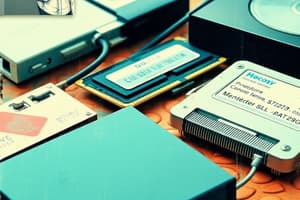Podcast
Questions and Answers
Which statement accurately describes floppy disks?
Which statement accurately describes floppy disks?
- Floppy disks are no longer in use and can store up to 1.44MB. (correct)
- Floppy disks have a rigid structure and are used in modern PCs.
- Floppy disks are made of flexible Mylar and suitable for high-capacity storage.
- Floppy disks are primarily used for streaming data in real-time.
What is a characteristic of hard disks?
What is a characteristic of hard disks?
- They have a single rigid platter coated with magnetic material.
- They are mainly used for temporary data storage only.
- They can hold hundreds of gigabytes and consist of multiple platters. (correct)
- Data is read and written by a laser without physical contact.
What could happen if the read/write head of a disk drive touches the disk surface?
What could happen if the read/write head of a disk drive touches the disk surface?
- The read/write head adjusts for better alignment.
- The disk drive automatically ejects the disk.
- Data transfer speeds increase significantly.
- Data becomes corrupted, a situation known as head crash. (correct)
In the context of hard disks, what does the term 'cluster' refer to?
In the context of hard disks, what does the term 'cluster' refer to?
Which of the following is a feature of magnetic disk storage?
Which of the following is a feature of magnetic disk storage?
What is the purpose of registers in a CPU?
What is the purpose of registers in a CPU?
Which of the following is NOT a Boolean operation?
Which of the following is NOT a Boolean operation?
What type of memory retains its data only while power is supplied?
What type of memory retains its data only while power is supplied?
Which describes a gate in computing?
Which describes a gate in computing?
What binary notation represents numeric values?
What binary notation represents numeric values?
The term 'mass storage' is best described as:
The term 'mass storage' is best described as:
Which operation represents a logical negation?
Which operation represents a logical negation?
Auxiliary memory is primarily used for:
Auxiliary memory is primarily used for:
What is the primary role of the Control Unit (CU) in relation to memory?
What is the primary role of the Control Unit (CU) in relation to memory?
Which of the following correctly describes a byte?
Which of the following correctly describes a byte?
What distinguishes SRAM from DRAM?
What distinguishes SRAM from DRAM?
How are main memory addresses organized?
How are main memory addresses organized?
In which scenario would a computer have insufficient memory space?
In which scenario would a computer have insufficient memory space?
What is the least significant bit in a memory cell?
What is the least significant bit in a memory cell?
Which of the following statements regarding ROM is true?
Which of the following statements regarding ROM is true?
Which memory type is typically used in most PCs due to its cost advantage?
Which memory type is typically used in most PCs due to its cost advantage?
What is the primary purpose of storing related data on the same cylinder in a hard disk?
What is the primary purpose of storing related data on the same cylinder in a hard disk?
Which statement best defines a sector in the context of hard disks?
Which statement best defines a sector in the context of hard disks?
What is a primary characteristic that distinguishes tapes from disks?
What is a primary characteristic that distinguishes tapes from disks?
What does the term 'cluster' refer to in the organization of data on hard disks?
What does the term 'cluster' refer to in the organization of data on hard disks?
What is the maximum storage capacity of a standard CD-ROM?
What is the maximum storage capacity of a standard CD-ROM?
What are the components of disk access time?
What are the components of disk access time?
Which of the following statements about cylinders on hard disks is true?
Which of the following statements about cylinders on hard disks is true?
Which optical disk type allows for data to be erased and re-recorded multiple times?
Which optical disk type allows for data to be erased and re-recorded multiple times?
What distinguishes a DVD from a standard CD?
What distinguishes a DVD from a standard CD?
What does zone recording in hard disks accomplish?
What does zone recording in hard disks accomplish?
What is the function of the erase-head found in magnetic tape storage?
What is the function of the erase-head found in magnetic tape storage?
Which of the following is a feature of flash memory?
Which of the following is a feature of flash memory?
In file storage terminology, what best defines a 'field'?
In file storage terminology, what best defines a 'field'?
How is data typically organized in sectors on a hard disk?
How is data typically organized in sectors on a hard disk?
In a database structure, which of the following entities contains a group of records?
In a database structure, which of the following entities contains a group of records?
What is a common issue with CD-RW disks when used with CD-ROM drives?
What is a common issue with CD-RW disks when used with CD-ROM drives?
What is the main purpose of ASCII in representing text?
What is the main purpose of ASCII in representing text?
What is the primary limitation of numeric value representation in computers?
What is the primary limitation of numeric value representation in computers?
How does Unicode differ from ASCII in representing text?
How does Unicode differ from ASCII in representing text?
In bitmap image representation, what does the term 'pixel' refer to?
In bitmap image representation, what does the term 'pixel' refer to?
What is the typical bit representation for a color pixel in RGB format?
What is the typical bit representation for a color pixel in RGB format?
Which of the following describes the process used to represent sound in digital formats?
Which of the following describes the process used to represent sound in digital formats?
What is the role of bit patterns in representing numeric values?
What is the role of bit patterns in representing numeric values?
Which technique is used in representing grayscale images more elaborately?
Which technique is used in representing grayscale images more elaborately?
Flashcards
Bit
Bit
The fundamental unit of digital information. It can be either 0 or 1.
Bit Pattern
Bit Pattern
A group of bits used to represent information, such as numbers, text, images, or sound.
Boolean Operation
Boolean Operation
An operation that works with true/false values (0s and 1s) and produces a true/false result.
Gate
Gate
Signup and view all the flashcards
Registers
Registers
Signup and view all the flashcards
Main Memory
Main Memory
Signup and view all the flashcards
Binary Notation
Binary Notation
Signup and view all the flashcards
Primary Memory
Primary Memory
Signup and view all the flashcards
Hard Disk
Hard Disk
Signup and view all the flashcards
Cluster
Cluster
Signup and view all the flashcards
Read/Write Head
Read/Write Head
Signup and view all the flashcards
Removable Hard Drive
Removable Hard Drive
Signup and view all the flashcards
Head Crash
Head Crash
Signup and view all the flashcards
Track
Track
Signup and view all the flashcards
Sector
Sector
Signup and view all the flashcards
Cylinder
Cylinder
Signup and view all the flashcards
Seek Time
Seek Time
Signup and view all the flashcards
Rotational Delay
Rotational Delay
Signup and view all the flashcards
Head Switching
Head Switching
Signup and view all the flashcards
Data Transfer
Data Transfer
Signup and view all the flashcards
Memory Cell
Memory Cell
Signup and view all the flashcards
Memory Address
Memory Address
Signup and view all the flashcards
RAM (Random Access Memory)
RAM (Random Access Memory)
Signup and view all the flashcards
SRAM (Static RAM)
SRAM (Static RAM)
Signup and view all the flashcards
DRAM (Dynamic RAM)
DRAM (Dynamic RAM)
Signup and view all the flashcards
ROM (Read-Only Memory)
ROM (Read-Only Memory)
Signup and view all the flashcards
How the CPU Finds Data
How the CPU Finds Data
Signup and view all the flashcards
Optical Disk
Optical Disk
Signup and view all the flashcards
CD-ROM
CD-ROM
Signup and view all the flashcards
CD-R
CD-R
Signup and view all the flashcards
CD-RW
CD-RW
Signup and view all the flashcards
Digital Versatile Disk (DVD)
Digital Versatile Disk (DVD)
Signup and view all the flashcards
Flash Memory
Flash Memory
Signup and view all the flashcards
Buffer
Buffer
Signup and view all the flashcards
Character Representation
Character Representation
Signup and view all the flashcards
ASCII
ASCII
Signup and view all the flashcards
Unicode
Unicode
Signup and view all the flashcards
Overflow
Overflow
Signup and view all the flashcards
Pixel Representation (Bitmap)
Pixel Representation (Bitmap)
Signup and view all the flashcards
RGB Color Model
RGB Color Model
Signup and view all the flashcards
Sound Sampling
Sound Sampling
Signup and view all the flashcards
Study Notes
Data Storage Overview
- Data storage encompasses the various methods of storing information, including bits, main memory, and mass storage.
Bits and Their Storage
- A CPU comprises a control unit and an arithmetic logic unit (ALU).
- The control unit manages the computer's operations.
- The ALU performs arithmetic and logical operations (e.g., +, -, ×, ÷, AND, OR, XOR, NOT).
- Registers are high-speed storage locations within the CPU.
- Registers store data or instructions required during current processing.
- Registers are faster than main memory.
- Registers transfer data to/from memory and store/accept data.
Main Memory
- Main memory, also known as primary memory and internal storage, stores instructions and data actively used by the program.
- Main memory loses its content when the computer is turned off.
- Memory uses addresses to locate data.
- The CPU references memory addresses to retrieve stored information.
- Memory cells, sometimes called bytes, provide storage for data and programs.
- Each memory cell has a unique address.
- Each location in main memory has an address.
- Main memory cells are usually organized as bytes (8 bits).
- Most significant bit is on the left, least on the right.
Boolean Operations
- Boolean operations work with true/false values (often represented as 0/1).
- Common Boolean operations include AND, OR, XOR (exclusive or), NOT.
- Tables display how Boolean operations operate on 0 and 1 input values.
Gates
- Logic gates are fundamental components of computer hardware.
- Logic gates implement Boolean operations electronically.
- Very Large Scale Integration (VLSI) allows for millions of gates on a single chip.
Memory Use in Operations
- Registers hold data directly related to the current process.
- Main memory holds data and instructions needed soon.
- Auxiliary memory holds data/programs for later use.
Binary Notation
- Binary notation represents numerical values using only 0 and 1.
- Computer systems primarily use binary.
Mass Storage
- Mass storage includes various persistent storage formats used to store information when the computer is turned off.
-
Magnetic disk drives (floppy disks, hard disks): data stored magnetically on platters or disks (used in computers).
- Floppy disks are a type of removable disk (outdated) and usually smaller capacity
- Hard disks are rigid (non-removable) drives in contemporary use with a substantially larger capacity.
-
Magnetic tape storage: sequential data access, typically low cost and high capacity - primarily used for large archive storage or back-up systems.
- Data stored in sequential format (must be accessed sequentially/one by one).
-
Optical disk storage (CDs, DVDs, Blu-ray): data stored using laser technology to create physical patterns.
- CDs (Compact Disks) store only up to 700MB (low capacity)
- DVDs have a higher storage capacity.
- Blu-ray disks have even higher storage capacity.
-
Flash memory (USB drives, SD cards): data stored electrically on flash chips, portable, relatively high speed but lower storage capacity in comparison to magnetic/optical disks.
-
File Storage and Retrieval
- Files are organized collections of data in mass storage.
- Files consist of records, each of which contain fields of data and a unique key or sequence.
- Data structure includes characters, fields, records, files and databases.
- Buffers are temporary storage locations used for transferring data between devices.
Representing Information as Bit Patterns
- All kinds of computer information are stored as bits and bit patterns.
- Characters: encoded using ASCII or Unicode.
- Numbers: represented using binary notation.
- Images: used raster techniques or bitmaps.
- Sound: stored using sampling techniques.
Studying That Suits You
Use AI to generate personalized quizzes and flashcards to suit your learning preferences.





